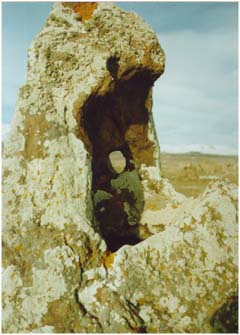 And those that didn't have holes, what were they for? "They
were all part of the same instrument," Herouni says. "Eye
holes were not enough without other points to fix the angle of
the sight. So we have stones to look through, and others
close by that were used to line up the stone, to establish the
angle of sight."
And those that didn't have holes, what were they for? "They
were all part of the same instrument," Herouni says. "Eye
holes were not enough without other points to fix the angle of
the sight. So we have stones to look through, and others
close by that were used to line up the stone, to establish the
angle of sight."
"There is
one stone, which can be called the keystone to the whole complex,
it has a bowl carved on one side. At first I looked at
that bowl and thought, 'What on earth could this be?'
Then it rained one evening, and the next day the bowl was filled
with water, and I thought, 'Of course! This is a leveling
stone!'"
By pouring
water into the bowl, Herouni believes the ancients could set
the angle of the keystone, thereby setting the other stones
into position. An ingenious method at the time.
"You can't tell me these people were simple," Herouni challenges.
"They understood geometry and the laws of physics long before
anyone in Europe began to look into the matter. This was
an incredible culture."
Herouni
points out three stones (#60,
62, 63) which form part of a single instrument, "a beautiful
and important instrument," he adds. "So many of these
stones look like animals or people. # 60 we called the
cock, or rooster, because of its shape. One tip is higher
than the other, and was a sighting point for #62, which has
an eye-hole that looks right over its tip. Then there
is #63, which has an eye-hole that also looks at the tip of
the rooster, but at a different angle. It was the leveling
stone for the first two."
|